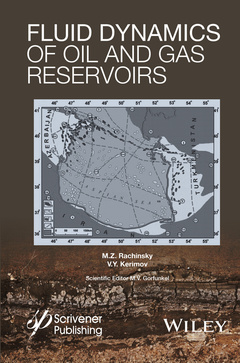Description
Fluid Dynamics of Oil and Gas Reservoirs
Authors: Rachinsky M. Z., Kerimov V. Y.
Language: English
Subjects for Fluid Dynamics of Oil and Gas Reservoirs:
Keywords
areas; petroliferous; mobile belts; dynamics; ix; alpine; geology; mobile; basins; gas; hydrogeochemical; geobaric; high pore; pore; formation; distribution; abnormally; spatial; high; patterns
267.60 €
In Print (Delivery period: 14 days).
Add to cart640 p. · 16.3x24.4 cm · Hardback
Description
/li>Contents
/li>Biography
/li>
Whether as a textbook for the petroleum engineering student or a reference for the veteran engineer working in the field, this new volume is a valuable asset in the engineer's library for new, tested methods of more efficient oil and gas exploration and production and better estimating methods. In this book, the authors combine a rigorous, yet easy to understand, approach to petrophysics and how it is applied to petroleum and environmental engineering to solve multiple problems that the engineer or geologist faces every day. Useful in the prediction of everything from crude oil composition, pore size distribution in reservoir rocks, groundwater contamination, and other types of forecasting, this approach provides engineers and students alike with a convenient guide to many real-world applications.
Fluid dynamics is an extremely important part of the extraction process, and petroleum geologists and engineers must have a working knowledge of fluid dynamics of oil and gas reservoirs in order to find them and devise the best plan for extraction, before drilling can begin. This book offers the engineer and geologist a fundamental guide for accomplishing these goals, providing much-needed calculations and formulas on fluid flow, rock properties, and many other topics that are encountered every day.
The approach taken in Fluid Dynamics of Oil and Gas Reservoirs is unique and has not been addressed until now in a book format. Readers now have the ability to review some of the most well-known fields in the world, from the USA to Russia and Asia.
Useful for the veteran engineer or scientist and the student alike, this book is a must-have for any geologist, engineer, or student working in the field of upstream petroleum engineering.
Fluid Dynamics in Petroliferous Areas of Mobile Belts ix
1. Geology and Oil and Gas Occurrences in the Alpine Mobile Belt Basins 1
1.1 Intermontane Troughs 1
1.2 Foredeeps 16
2. Hydrogeochemical Field of the Alpine Mobile Belt Basins 31
2.1 Intermontane Depressions 32
2.2 Foredeeps 129
3. Geobaric Field in Alpine Mobile Belt Basins 181
3.1 Abnormally High Pore and Formation Pressures: Their Nature, Types, Identification and Diagnostics 182
3.2 Patterns in Spatial Distribution of Abnormally High Pore and Formation Pressures 195
4. Geotemperature Field in Alpine Mobil Belt Basins 251
4.1 Geotemperature Regime of the Sediment Cover 252
4.2 Geothermal Regime in the South Caspian Depression 259
4.3 Geothermal Field of Local Structures 267
5. Present-Day Geo-Fluid-Dynamics of Alpine Mobile Belt Basins 273
5.1 Abnormally-High Fluid Pore Pressure as a Factor in the Formation of Faults, Structure Plans, Regional and Local Folded Structures 273
5.2 Regional Dynamics of Ground Waters 287
5.3 Geobaric Parameters of Natural Fluid Migration 321
5.4 Geotemperature Parameters of Fluid Migration 358
6. Hydrocarbon Generation, Migration and Accumulation in the South-Caspian Basin 365
7. Geo-Fluid-Dynamic Mechanisms and Factors in the Formation, Location and Forecast of Oil and Gas Occurrences in Alpine Mobile Belt Basins 397
7.1 Role of Abnormally High Pressure in the Formation, Placement and Forecast of Regional and Local Oil and Gas Occurrences 398
7.2 Role of Ground Water Discharge Zones and Foci in the Formation and Placement of Regional and Local Oil and Gas Occurrences 408
8. Qualitative Criteria and Quantitative Attributes of Commercial Oil and Gas Occurrences in Alpine Mobile Belt Basins 431
8.1 Hydrochemical Associations Between Ground Water and Hydrocarbon Accumulations 431
8.2 Quantitative Parameters in Correlation Between Tectonic Features of Local Structures, Ground Water Dynamics and Oil and Gas Occurrences 446
8.3 Quantitative Correlation Between Hydrocarbon Saturation and Thermobaric Regime of Local Structures 465
9. Geologo-Mathematical Models of Oil and Gas Accumulation in Alpine Mobile Belt Basins 483
9.1 Techniques of Local Structures Hydrocarbon Reserves Forecast and Estimation 483
9.2 Zonal and Regional Geologic Models of Oil and Gas Occurrence in Alpine Mobile Belt Basins 484
10. Geo-Fluid-Dynamical Parameters of Oil and Gas Occurrence on Local Structures and in Zones of Dominant Oil and Gas Accumulation 491
10.1 The South Caspian Depression 491
10.2 The Other Alpine Regions 511
11. Attempt on Regional Situation Analysis, Conceptual Resource Estimation and Procedure of Strategic Decision-Making in Planning and Conduct of Exploration and Appraisal Operations (Example of the South Caspian Basin) 515
Conclusions 579
References 585
Index 609
M.Z. Rachinsky, PhD, is a professor and member of the Russian Academy of Natural Sciences, having won the 2006 Kapitsa award for Outstanding Scientific Achievement. Previous positions include Professor in the Department of Oil and Gas Geology at Azerbaijan State Petroleum Academy and he has been the Principal Geologist at Environmental Solutions International, LLC in Baltimore, Maryland, USA, since 1998. He has published over 120 scientific publications and 3 monographs.
V.Y. Kerimov holds his PhD in geology from the Azerbaijan Oil and Chemistry Institute and is a professor and the Head of the Department of Technical Means of Oil and Gas Exploration at the Gubkin Russian State University of Oil and Gas. He is a member of the Academy of Mining Sciences and has published over 140 scientific publications and 20 monographs and textbooks.
These books may interest you

Mechanics of Fluid Flow 222.68 €



